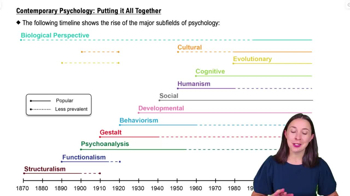Table of contents
- 1. Introduction to Psychology1h 43m
- 2. Psychology Research2h 20m
- 3. Biological Psychology2h 41m
- 4. Sensation and Perception28m
- 5. Consciousness and Sleep32m
- 6. Learning41m
- 7. Memory34m
- 8. Cognition37m
- 9. Emotion and Motivation35m
- 10. Developmental Psychology33m
- 11. Personality48m
- 12. Social Psychology41m
- 13. Stress and Health41m
- 14. Psychological Disorders44m
- 15. Treatment47m
1. Introduction to Psychology
Contemporary Psychology: Putting it All Together
Struggling with Psychology?
Join thousands of students who trust us to help them ace their exams!Watch the first videoMultiple Choice
Freud proposed that there is a(n) _____ mind into which we repress all of our threatening urges and desires.
A
conscious
B
unconscious
C
subconscious
D
dark
 Verified step by step guidance
Verified step by step guidance1
Begin by understanding the key concepts in Freud's theory of the mind. Freud proposed that the mind is divided into three parts: the conscious, the preconscious, and the unconscious.
The conscious mind includes everything we are aware of and can think about rationally. It is the aspect of our mental processing that we can access and articulate.
The preconscious mind contains thoughts and feelings that are not currently in our conscious awareness but can be brought to consciousness easily.
The unconscious mind, according to Freud, is the part of the mind that houses all of our repressed desires, urges, and memories. These are not easily accessible and often influence our behavior and emotions without our awareness.
In the context of the problem, Freud's theory suggests that threatening urges and desires are repressed into the unconscious mind, which is the correct answer to the question.

 4:54m
4:54mWatch next
Master Contemporary Psychology with a bite sized video explanation from Hannah Gordils
Start learningRelated Videos
Related Practice




















